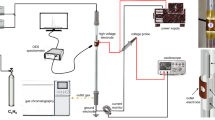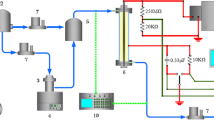Abstract
The destruction of hexafluoroethane (C2F6), also known as R-116, was investigated in a nonthermal plasma reactor packed with dielectric pellets. The effects of the feed gas composition and the input power on the destruction of C2F6 were examined. The feed gas composition was varied by changing the oxygen content, the argon content and the initial C2F6 concentration. An increased input power led to increased C2F6 destruction as a result of promoting the electron-molecule collisions to dissociate C2F6 molecules. The addition of argon to the feed gas greatly improved the C2F6 destruction by reducing the energy losses due to vibrational excitation and dissociation of N2 molecules, while the increases in the oxygen content and the initial C2F6 concentration decreased the destruction efficiency. The byproducts including CO2, CO, COF2, CF4, SiF4, NO2, and N2O were identified, and the destruction mechanisms were elucidated, referring to these compounds. The most abundant byproduct was found to be carbonyl fluoride (COF2), indicating that it serves as an important medium to convert C2F6 into CO2. The energy requirement for the C2F6 destruction was in the range of 8.2–45.3 MJ/g, depending on the initial concentration.
Similar content being viewed by others
References
Barker, J.R., 1995. Progress and Problems in Atmospheric Chemistry. World Scientific, London, UK.
Chang, M.B., Yu, S.J., 2001. An atmospheric-pressure plasma process for C2F6 removal. Environmental Science and Technology, 35(8):1587–1592. [doi:10.1021/es001556p]
Chen, H.L., Lee, H.M., Cheng, L.C., Chang, M.B., Yu, S.J., Li, S.N., 2008. Influence of nonthermal plasma reactor type on CF4 and SF6 abatements. IEEE Transactions on Plasma Science, 36(2):509–515. [doi:10.1109/TPS.2008.918675]
Delattre, J.L., Friedman, T.L., Stacy, A.M., 1999. Destructive abatement of CF4 and C2F6 via a plasma induced reaction with CaO. Journal of Vacuum Science and Technology B: Microelectronics and Nanometer Structures, 17(6):2664–2666. [doi:10.1116/1.591044]
Futamura, S., Sugasawa, M., 2008. Mechanisms for formation of organic and inorganic by-products and their control in nonthermal plasma chemical processing of VOCs. International Journal of Environment and Waste Management, 2(4/5):471–483. [doi:10.1504/IJEWM.2008.021787]
Hartz, C.L., Bevan, J.W., Jackson, M.W., Wofford, B.A., 1998. Innovative surface wave plasma reactor technique for PFC abatement. Environmental Science and Technology, 32(5):682–687. [doi:10.1021/es9706514]
Kucukarpaci, H.N., Lucas, J., 1979. Simulation of electron swarm parameters in carbon dioxide and nitrogen for high E/N. Journal of Physics D: Applied Physics, 12(12):2123–2138. [doi:10.1088/0022-3727/12/12/014]
Lee, M.C., Choi, W., 2004. Development of thermochemical destruction method of perfluorocarbons (PFCs). Journal of Industrial & Engineering Chemistry, 10(1):107–114.
Mallard, W.G., Westley, F., Herron, J.T., Hampson, R.F., Frizzell, D.H., 1998. Chemical Kinetics Database, Version 2Q98. National Institute of Standards and Technology (NIST), USA.
Mizeraczyk, J., Jasinski, M., Zakrzewski, Z., 2005. Hazardous gas treatment using atmospheric pressure microwave discharges. Plasma Physics and Controlled Fusion, 47(12B):589–602. [doi:10.1088/0741-3335/47/12B/S43]
Mok, Y.S., Kim, J.H., Nam, I.S., Ham, S.W., 2000. Removal of NO and formation of byproducts in a positive-pulsed corona discharge reactor. Industrial and Engineering Chemistry Research, 39(10):3938–3944. [doi:10.1021/ie000239o]
Mok, Y.S., Demidyuk, V., Whitehead, J.C., 2008. Decomposition of hydrofluorocarbons in a dielectric-packed plasma reactor. Journal of Physical Chemistry A, 112(29): 6586–6591. [doi:10.1021/jp8020084]
Motlagh, S., Moore, J.H., 1998. Cross sections for radicals from electron impact on methane and fluoroalkanes. Journal of Chemical Physics, 109(2):432–438. [doi:10.1063/1.476580]
NIST (National Institute of Standards and Technology), 2009 Chemistry Web Book. Available from http://webbook.nist.gov/chemistry [Accessed on Oct. 15, 2009].
Okubo, M., Kametaka, H., Yoshida, K., Yamamoto, T., 2007. Odor removal characteristics of barrier-type packed-bed nonthermal plasma reactor. Japanese Journal of Applied Physics, 46(8a):5288–5293. [doi:10.1143/JJAP.46.5288]
Ricketts, C.L., Wallis, A.E., Whitehead, J.C., Zhang, K., 2004. A mechanism for the destruction of CFC-12 in a nonthermal, atmospheric pressure plasma. Journal of Physical Chemistry A, 108(40):8341–8345. [doi:10.1021/jp047546i]
Sun, J.W., Park, D.W., 2003. CF4 decomposition by thermal plasma processing. Korean Journal of Chemical Engineering, 20(3):476–481. [doi:10.1007/BF02705551]
Takaki, K., Urashima, K., Chang, J.S., 2004. Ferro-electric pellet shape effect of C2F6 removal by a packed-bed-type nonthermal plasma reactor. IEEE Transactions on Plasma Science, 32(6):2175–2183. [doi:10.1109/TPS. 2004.837614]
Takaki, K., Urashima, K., Chang, J.S., 2006. Scale-up of ferro-electric packed bed reactor for C2F6 decomposition. Thin Solid Films, 506–507:414–417. [doi:10.1016/j.tsf.2005.08.104]
Tsai, W.T., Chen, H.P., Hsien, W.Y., 2002. A review of uses, environmental hazards and recovery/recycle technologies of perfluorocarbons (PFCs) emissions from the semiconductor manufacturing processes. Journal of Loss Prevention in the Process Industries, 15(2):65–75. [doi:10.1016/S0950-4230(01)00067-5]
Urashima, K., Kostov, K.G.., Chang, J.S., Okayasu, Y., Iwaizumi, T., Yoshimura, K., Kato, T., 2001. Removal of C2F6 from a semiconductor process flue gas by a ferroelectric packed-bed barrier discharge reactor with an adsorber. IEEE Transactions on Industry Applications, 37(5):1456–1463. [doi:10.1109/28.952521]
Yoshida, K., Rajanikanth, B.S., Okubo, M., 2009. NOx reduction and desorption studies under electrical discharge plasma using a simulated gas mixture: a case study on the effect of corona electrode. Plasma Science and Technology, 11(3):327–333. [doi:10.1088/1009-0630/11/3/15]
Author information
Authors and Affiliations
Corresponding author
Rights and permissions
About this article
Cite this article
Kim, D.H., Mok, Y.S., Lee, S.B. et al. Destruction of hexafluoroethane in a dielectric-packed bed plasma reactor. J. Zhejiang Univ. Sci. A 11, 538–544 (2010). https://doi.org/10.1631/jzus.A0900734
Received:
Accepted:
Published:
Issue Date:
DOI: https://doi.org/10.1631/jzus.A0900734




